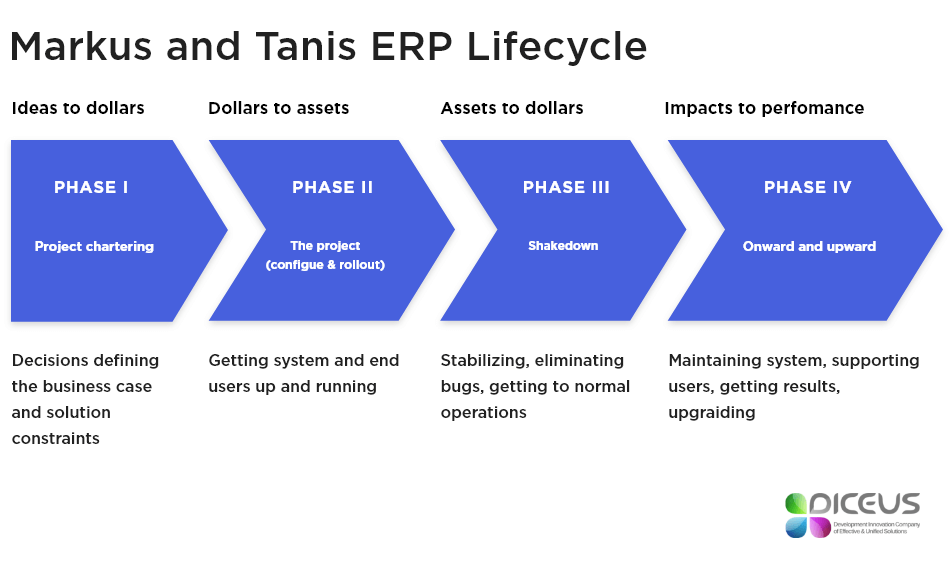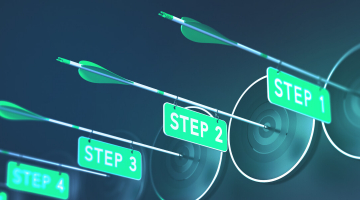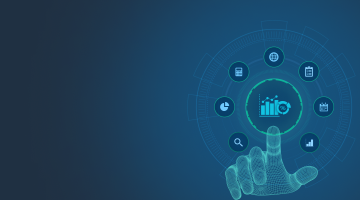

ERP implementation life cycle: 11 models and their phases
On our blog, you could read a lot of articles on ERP topics. Below you can find a complete list of links to those posts. Despite you’ve probably read about ERP implementation phases, we decided to explain ERP life cycle in detail. Due to a great number of research papers written on this topic, there is no general view of the life cycle, thus you should make up your mind on what model to choose for your organization.
First off, this article will be based on the findings of the conference paper written by Tingting Huang and Kazuhiko Yasuda which contained a comprehensive annotated bibliography review of literature related to the ERP life cycle concept. It turned out that the authors of the report have selected 26 original models of ERP life cycle stages introduced by different researchers.
Just imagine, 26 papers! Each of those papers has its own description of ERP. There’s no wonder now why companies adjust their ERP portal to a certain model.
Read more on the topic:
ERP system types.
What is an ERP implementation cycle?
To implement ERP (enterprise resource planning) software, you should clearly understand what an ERP implementation lifecycle is. Simply put, it is a process consisting of a few steps (the number of steps may differ, however, usually, these are eight), from a discovery phase and planning to system launch. Typically, such a project may last from six to 12 months. For example, the ERP implementation phases may look like this:
- Selection of an ERP product
- Project planning
- Gap analysis
- Reengineering
- Testing
- Training
- Application
- Maintenance
How different are 11 models of ERP life cycle?
Esteves and Pastor first cited the ERP life cycle in 1999. They offered a six-phase framework and chose dimensions to present distinct viewpoints. Each phase can be analyzed by four dimensions. They mentioned that most researchers focused only on the first three phases, but it was also important to have a general vision to prevent future problems. The significance of the framework is the retirement phase. They provided a research map of ERP system’s issues and tried to draw the attention of practitioners and researchers to find the effects of the ERP system in organizations.
Esteves and Pastor ERP life cycle

Markus and Tanis ERP life cycle
In 2000, Markus and Tanis introduced a four-phase model consisting of the following stages:
- Project chartering
- The project
- Shakedown
- Onward and upward

Soh and Markus ERP life cycle
Based on the study of two dozen firms, the researchers adopted the framework of Soh and Markus (1995) to the enterprise systems experience with some changes. They also intended to provide a theoretical framework for analyzing the business value of enterprise systems. Phases, starting conditions, goals, plans, and quality of execution are the essential elements of this framework.
Brehm and Markus ERP life cycle
Brehm and Markus (2000). Earlier, a traditional software life cycle was the process of developing, implementing, and maintaining by a company for its internal uses. However, most of the development processes are done by a software vendor nowadays. By pointing out the deficiency of the life cycle activities performed by software vendors, the researchers tried an approach to building a new life cycle model from the traditional SDLC model in 2000. They proposed the “divided software life cycle” (DSLC) model, which consisted of three main stages:
- Initial development and adoption of the ERP package
- Evolution of the ERP package
- Adopter’s implementation and feedback from adapter to vendor
Stefanou ERP life cycle
In 2001, Stefanou pointed out the importance of the ex-ante evaluation and selection process of the enterprise systems. ERP evaluation is a complex, multi-facet activity including the evaluation of costs and benefits of ERP, and also the organizational, technological, and behavioral impact over time, which has to be taken into consideration throughout the entire life cycle. In contrast to the traditional linear model, this framework was not sequential but with some assumed circles. The author emphasized the importance of the phases before the implementation, and the perspective thinking regarding the benefits and costs, both financial and non-financial measures, throughout the whole cycle.

De Souza and Zwicker ERP life cycle
Another life cycle model is the research of De Souza and Zwicker in 2001. By a multiple-case study in eight Brazilian companies, two different models for the large enterprises and the small and medium enterprises (SMEs) were proposed based on their former model. In 2009, they unified the main features of many models into one with well-defined stages. The interesting part is the last stage. It is divided into the utilization stage and management stage, which exist at the same time. Additionally, the last stage feeds back the implementation stage whenever new needs appear. Although they mentioned the “retirement” stage may be one of the choices to improve the ERP system in organizations, this possibility is not included in their model.
Ehie and Madsen ERP life cycle
Ehie and Madsen (2005) identified eight factors affecting successful ERP implementation. Based on the experiences of consultants and the literature, a five-stage ERP implementation process was proposed in 2005. The five major phases are as follows:
- Project preparation
- Business blueprint
- Realization
- Final preparation
- Go live and support
Bento and Costa ERP life cycle
Bento and Costa (2013) are one of the latest researches on the life cycle model of ERP. They divided the cycle into three phases and four stages and they were among the few scholars that suggested the decline phase throughout the ERP life cycle. They tried to establish a different perspective on many areas such as the initial phase. Additionally, 12 hypotheses during the ERP life cycle were proposed for future research.
Law et al ERP life cycle
Law et al. (2010). Different from most scholars, Law et al. focused on the maintenance and support service after the implementation phase. By adopting a case study approach, the importance of planning and management of that service was proved. Based on the implementation model of Kwon and Zmud, they divided the project’s life cycle into four phases. To look at the relevant issues in a real-life context, two projects in an American-based multinational company with a strong presence in the Greater China region were the major objects.
Kumar and Gupta ERP life cycle
Kumar and Gupta tried to reduce the failure of ERP implementation by introducing Knowledge Management in the organization in 2011. They proposed an eleven-phase model of ERP implementation lifecycle with two optional phases. The life cycle was considered to be used as the framework of organizing communities of practice composed of the different groups to overcome the difficulties of transferring, but the model was not been explained in detail, and the original of it as well.
Dantes and Hasibuan ERP life cycle
Dantes and Hasibuan (2011) introduced a conceptual framework of key success factors based on previous research; the ERP implementation process and components involved in these processes were two dimensions of the framework. The specific processes were described in three perspectives: operational, managerial, and strategic.
A free ERP selection list: How to pick up the best-suited option?
Today when vendors offer a great variety of custom-designed IT products and out-of-the-box SaaS ERP solutions, it’s quite difficult to choose the one that will fit your business needs and goals. You might have your own selection criteria and yet we tried to offer some useful information. According to the article written by Balint Molnar and Andras Benczur, there are the following criteria for choosing ERP modules:
- Current market position and long-term sustainability and viability of market of ERP system.
- The alignment and/or the capability for adjustment of the potential ERP system to the specific industrial sector or business area.
- Financial and business parameters of the potential vendor.
- The degree of dedication of rival enterprises to the implementation and application of ERP solutions.
- Interoperability, capability for integration to other legacy systems to be kept in operation.
- The applied technologies for data management, software, and information processing.
- The support provided by the vendor at the introduction and operation of the system.
- The costs and options for maintenance, upgrade, update and adaptation to the changing legal environment.
- Language versions, localization opportunities in the case of multi-national, global companies.
- The existence of country-specific solutions in some business areas, for example accounting.
- IT-networking capability of the system to be adjusted to the recent state of the decentralization-centralization demand.
- The new product is the pre-condition to realize the business strategy plan.
- The new IS provides better reliability, the higher service level for customers.
- To improve efficiency and to make more transparent to the business process within the business group.
- The system should support business planning and, consequently, cost efficiency.
- The system should provide support for serving the clients.
Related article: ERP for banking industry: Pros and cons of systems
How to choose an IS according to Stefanou’s ERP selection framework?
Stefanou introduced another vision in the selection process. He created a framework according to which companies can choose the best-suited IS/IT product. The framework consists of three phases:
Business vision
During the first phase, the company’s directions and objectives should be clearly determined.
Requirements and constraints
In the second phase, future and current changes in the organization should be taken into account.
Product evaluation and selection
During the third and the last phase, organizations choose the appropriate vendor according to the following criteria:
- Requirements fulfillment
- The functionality of the enterprise system’s critical core modules
- Industry-specific solutions offered
- Extended applications availability/ compatibility
- Critical business processes supported by the ERP system
- External experts availability in ERP system
- Technology partner availability/expertise
- Consulting offered by vendor or third party
- Vendor’s financial position
- Pricing models offered
Different vendors and third-party firms offer many core and extended modules and support services. The decision to acquire a particular system and the process of choosing is becoming increasingly complex in today’s changing and competitive environment. Enterprises pursuing systems integration must evaluate and select products that contribute to this goal without of course sacrificing the functionality of applications they believe are crucial for their business. A careful selection of vendors, products, and services is necessary but the final decision has to be made considering the number of organizational changes required for the adoption and the launch of the selected enterprise system.





